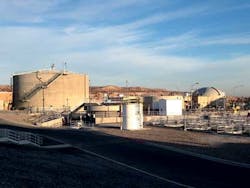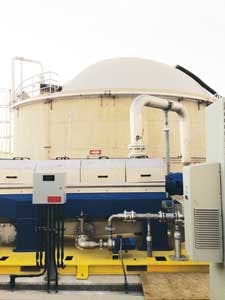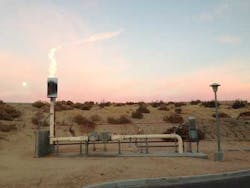By William Atkinson
By nature, Logan Olds, general manager of the Victor Valley Wastewater Reclamation Authority (Hesperia, Calif.), is a curious man and is passionate about his industry. As such, while visiting a friend in Scotland, it was no surprise that he wanted to use the opportunity to visit some wastewater treatment plants and similar facilities while there. One visit took him to a landfill, which was using an interesting technology that involved digesting food waste.
The technology was called Helios, offered by Anaergia (www.anaergia.com), which uses high solids anaerobic digestion technology to convert food waste into biogas. "I was impressed with the equipment and mixing technology that they had," said Olds. "I was specifically impressed with the different types of feedstock it could receive."
Victor Valley Water Reclamation Authority (VVWRA) is an independent agency that is equally governed by leaders from its member communities, which include Apple Valley, Hesperia, Victorville, Oro Grande, and Spring Lake Valley.
Anaergia provides sustainable solutions for the generation of renewable energy and the conversion of waste to resources. The company, based in Burlington, Ontario, Canada, operates out of 16 offices in North America, Europe and Asia.
Upon returning to the U.S., Olds contacted Anaergia to brainstorm potential technology opportunities for VVWRA. Executives at Anaergia mentioned a new technology, Omnivore, which seemed ideal for the Authority.
Omnivore is a recuperative thickening device - a type of digestion technology. It can be installed as a retrofit package for existing digesters in wastewater treatment plants, designed to increase their capacity and their ability to digest higher volumes.
The Omnivore system processes waste streams with solid content two to three times higher than conventional digesters by decoupling the solids retention time from the hydraulic retention time using proprietary mixing and recuperative thickening processes. The net result is double the digestion capacity in the same digester volume.
Anaergia executives mentioned to Olds that they had obtained a $2-million grant from the California Energy Commission (CEC) to test Omnivore technology in the U.S. The company was also contributing an additional $600,000 for the project. "We jumped at the opportunity, because we have excellent digestion capacity," said Olds.
What resulted is the Omnivore Project at VVWRA. "It's a demonstration project and has not been done anywhere else," said Olds. "There are currently no other installations of this technology in the U.S."
VVWRA elected to retrofit one of its small digesters using a different type of mixer, installing a separation device in order to increase the solids content of that digester. With these modifications, the digester is able to double or even triple its capacity to digest solids or receive external waste. The goal is to generate more biogas using the digester and also be able to accept grease and solid waste streams that enter the plant as a way to produce even more gas.
"We are currently in the process of commissioning the Omnivore system at Victor Valley," said Steve Watzeck, CEO of Anaergia. "It is starting up now (spring 2014). All of the work involved to retrofit one of Victor Valley's conventional digesters to Omnivore has been done."
Demonstration to track performance began in spring 2014 for a period of 13 months. Over this time, there will be several tests combining sludge from the wastewater treatment plants at different rates.
"So far, I have been impressed with the quality of the equipment, construction and installation of Omnivore," said Olds. "Retrofit projects can be challenging. However, this has been the easiest one I have been involved with."
While Omnivore has benefits on its own, the real value, as VVWRA and Anaergia see it, is what can be done with the biogas that is produced.
"Our goal is to demonstrate that we can operate our existing infrastructure more effectively," said Olds. "With recuperative thickening or even with traditional digesters, the ability to co-digest an additional waste stream can bring added value to the facility, whether it be through [minimizing] tipping fees or by producing power from the additional methane that is generated as a result of the decomposition."
So, according to Olds, the new goal is to find ways to diversify VVWRA such that it is not only providing wastewater treatment but also creating other opportunities to generate revenue or provide additional value for ratepayers.
In April 2013, in line with this goal, the VVWRA board unanimously voted to enter into a 20-year power purchase agreement with Anaergia that is designed to save taxpayers millions of dollars over the life of the project.
Under the agreement, Anaergia will utilize the biogas that is currently being flared to produce thousands of megawatt hours of renewable electricity each year. The energy will be used on-site for plant operations and will reduce VVWRA's dependency on energy from local utilities.
Anaergia designed, built and will own the renewable energy system, with no capital cost to VVWRA. As part of the agreement, VVWRA is installing two 800-kilowatt internal combustion engines that will use the biogas generated from the sludge from VVWRA Digesters #4 and #5, in addition to the gas that the Omnivore Project will generate.
This will bring the total internal power generation at the plant to 1.3 megawatts. Currently, the plant is using an average of 1.1 megawatts, meaning, in theory, that the system will generate 0.2 megawatts of energy more than it uses.
Under the biogas-to-energy agreement with Anaergia, VVWRA will pay $734,000 per year as a fixed price for 20 years (a total of about $15 million) for the cost of power that Anaergia will provide back to VVWRA. That is, VVWRA will pay this money to Anaergia for the power that it uses, rather than to the local electric utility.
In talking with its local electric utility, VVWRA was able to estimate power costs from the utility over the next 20 years and came to the conclusion that by paying the fixed rate to Anaergia for that period of time, it could potentially save $9 million over the 20 years. In addition, there is no escalation in the agreement with Anaergia. As negotiated by Anaergia and VVWRA, the charge for power is fixed and includes the cost of the engines and installation.
"The biogas-to-energy system is currently under construction, and we expect it to be started up later in 2014," said Watzeck. "It will take all of the biogas from the facility and turn it into energy to power the facility."
Olds added, "We should be energy-neutral before the end of 2014."
There are, however, two potential downsides to this two-phase (Omnivore and Biogas-to-Fuel) project. One would be if VVWRA is unable to produce enough biogas to provide sufficient fuel for the engines to power the facility. That is, the Biogas-to-Energy project can only work if VVWRA is able to provide enough of the prime matter (biogas) that is necessary in order to produce energy. If it can't provide enough prime matter, it will then need to purchase natural gas to offset the lack of energy production.
"This should not be a problem," said Watzeck. "Omnivore can take existing anaerobic digesters and create a high solid anaerobic digestion process. Omnivore allows a digester to operate at much higher solid levels than a conventional digester. Omnivore gets 40 to 50 percent increased gas production over conventional plants. The technology also provides the opportunity to co-digest external organic waste streams. Victor Valley is bringing in pre-consumer food processing waste streams to provide additional organic feedstocks to boost the gas production."
If, for some reason however, the plant is unable to produce enough power to run its operations, VVWRA still has the option of purchasing its power from a local utility and is not required to pay Anaergia for power that it is unable to provide.
A second potential risk is that, sometime over the next 20 years, a new energy source becomes available that causes the local utility's rates to plummet below what VVWRA is contracted to pay Anaergia.
The Future
While Anaergia does not currently have any other Omnivore projects in the U.S., it does have two other biogas-to-energy projects operating at wastewater treatment facilities in California - the San Jose Water Pollution Control Plant and the Inland Empire Utilities Agency. "Here, we are taking existing biogas and using fuel cells to convert it to energy," said Watzeck.
Anaergia is able to install Omnivore as a retrofit package for any existing wastewater treatment plant. "We can take existing digesters and convert them into Omnivores, or we can install Omnivore as an add-on to an existing plant," said Watzeck.
As Watzeck sees it, the trend of the future is for municipal wastewater treatment plants to maximize resource recovery to generate renewable energy. "In fact, it is very possible for these plants to make their facilities not just energy-neutral but energy positive," he said.
Olds is already envisioning this. Another goal of VVWRA is to implement an interconnect agreement with the city of Victorville to provide any excess power generated by the Authority to the local utility. This would not only contribute to the goal of making VVWRA energy-independent but would also make it a net energy producer, generating revenue from the sale of power.
About the Author: William Atkinson is a correspondent for WaterWorld Magazine. He has been a full-time freelance business magazine writer since 1976, specializing in infrastructure, sustainability, supply chain, risk management, and safety/health.





